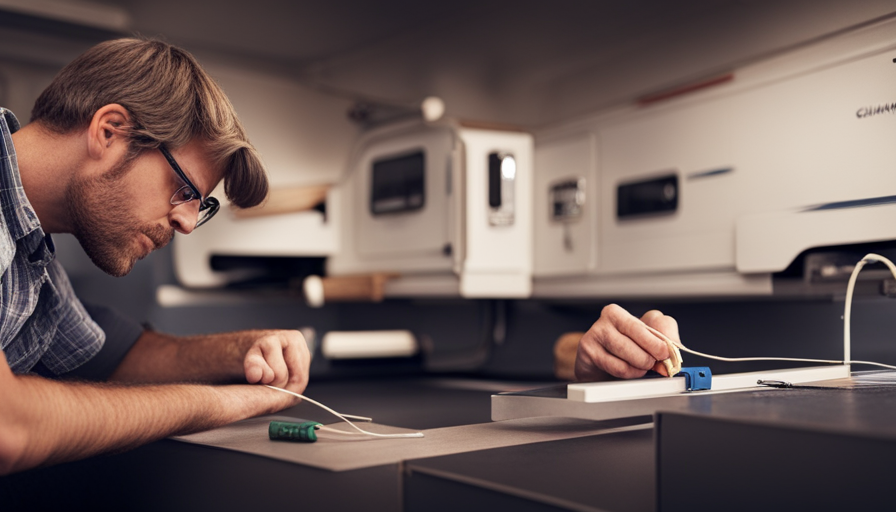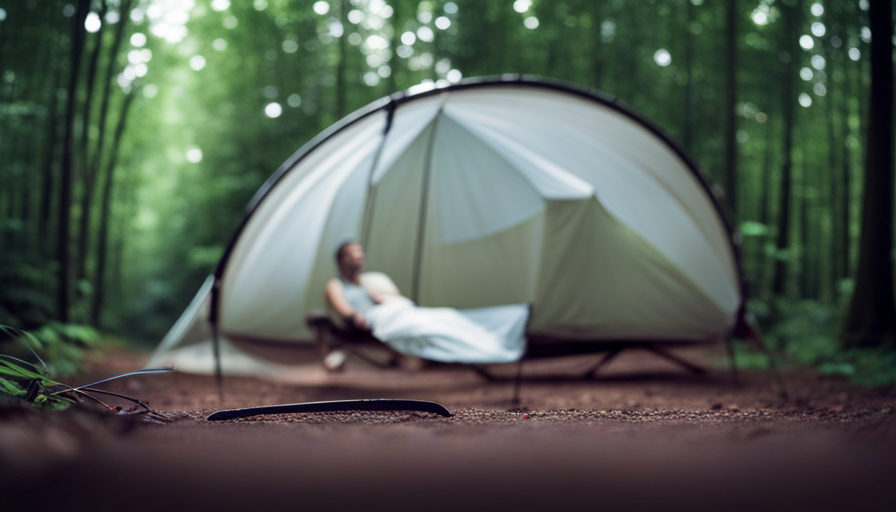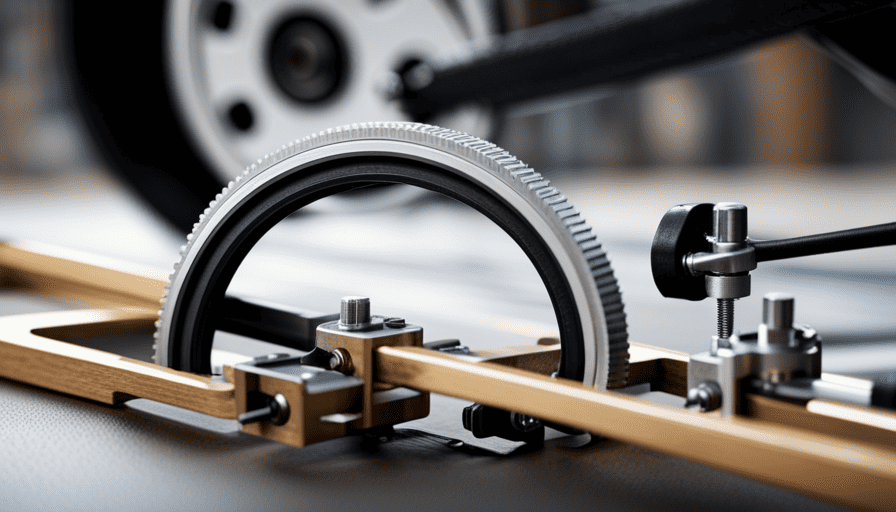Imagine the scene: a chilly winter day dawns, and as you venture outdoors, a snug hideaway greets you. The fragrance of pine fresh in the air, and a gentle sprinkle of snow blankets the earth. Nearing your camper, a comforting and welcoming area awaits, offering shelter from the biting cold of winter.
How did you achieve this winter wonderland? By skirting your camper, of course! Skirting is the process of insulating the bottom of your camper to keep the cold air out and the warm air in.
In this article, we will guide you through the steps to skirt your camper for winter. From assessing insulation needs to installing a moisture barrier and adding insulation to the underbelly, we have you covered. So, grab your tools and let’s get started on creating a cozy and protected camper for the winter season.
Key Takeaways
- Insulation options for skirting include foam panels, fiberglass, and spray foam.
- Assess the camper’s insulation needs by checking for drafts and cold spots.
- Gather materials such as insulation, foam boards, and heavy-duty tape for skirting.
- Install skirting panels using screws or suitable fasteners and leave a small gap at the bottom for ventilation.
Assess Your Camper’s Insulation Needs
Now it’s time for us to figure out how well our camper is insulated so we can keep cozy during those winter adventures. Insulation is crucial in maintaining a comfortable temperature inside the camper and reducing heat loss.
There are a few insulation options to consider, such as foam panels, fiberglass, or spray foam. Foam panels are easy to install and provide excellent thermal protection, while fiberglass is a more affordable option that offers decent insulation. Spray foam, on the other hand, provides superior insulation but can be more challenging to apply.
To assess our camper’s insulation needs, we can start by checking for any drafts or cold spots. Feel around windows, doors, and vents for any air leaks. Additionally, inspect the walls, ceiling, and floor for insulation thickness and quality. Consider upgrading or adding insulation in these areas if necessary.
Energy efficiency is another important factor to consider when assessing insulation. Look for ways to minimize energy loss, such as sealing gaps with weatherstripping or caulking. Also, consider installing thermal curtains or window film to further enhance insulation.
Now that we have assessed our camper’s insulation needs and identified any areas for improvement, we can move on to gathering the necessary materials for skirting.
Gather the Necessary Materials for Skirting
First, you’ll need to gather all the materials required for protecting your camper from the cold, like insulation, foam boards, and heavy-duty tape.
Insulation options for camper skirting include fiberglass batts, rigid foam boards, and reflective foil insulation. Fiberglass batts are affordable and widely available, but they may not offer the highest level of insulation. Rigid foam boards, on the other hand, provide excellent insulation and are easy to cut and install. Reflective foil insulation is another option, which helps to reflect heat back into the camper.
Deciding between a DIY installation or hiring a professional will largely depend on your experience and comfort level with home improvement projects. DIY installation can save you money, but it requires careful attention to detail and proper measurements. Professional installation ensures a high-quality result, but it can be more expensive.
Once you have gathered all the necessary materials, you can move on to the next step of measuring and preparing the skirting panels. This will ensure a proper fit and an effective barrier against the cold.
Measure and Prepare the Skirting Panels
To effectively protect your camper from the cold, start by carefully measuring and preparing your skirting panels. Accurate measurements are crucial to ensure a proper fit and maximum insulation.
Begin by measuring the length and height of each side of your camper, taking into account any obstacles such as stairs or utility hookups. Use a tape measure and write down these measurements for reference.
When choosing panel materials, consider durability and insulation. Insulated vinyl panels are a popular choice as they provide both strength and thermal protection. They’re also easy to clean and maintain. Other options include plywood or aluminum panels, which can be more cost-effective but may not offer the same level of insulation.
Now, let’s evoke an emotional response with a bullet list:
- Stay cozy and warm even in the harshest winter conditions.
- Protect your camper from freezing temperatures and avoid costly repairs.
- Create a comfortable and inviting space to enjoy the winter season.
- Ensure your family’s safety and well-being during winter camping adventures.
By following these measuring techniques and choosing the right panel materials, you can effectively prepare your skirting panels. Once you’ve completed this step, you can move on to installing a moisture barrier to further protect your camper from the winter elements.
Install a Moisture Barrier
Create a barrier between the elements and your home-on-wheels by installing a moisture shield, like a protective shield that shields a knight from harm. Moisture prevention is crucial when skirting a camper for winter, as it helps to keep the interior dry and free from potential damage.
To ensure effective moisture prevention, there are a few skirting installation tips to keep in mind. Firstly, make sure to choose a high-quality moisture barrier material, such as heavy-duty plastic sheeting or specialized RV skirting. These materials are designed to withstand harsh weather conditions and provide optimal protection against moisture infiltration.
Measure the dimensions of your camper and cut the moisture barrier to fit accordingly, leaving a few extra inches for overlapping.
Next, attach the moisture barrier to the bottom of your camper using a combination of adhesive and fasteners. Start at one end and work your way across, making sure to securely fasten the barrier to the camper’s frame. Pay extra attention to areas where water may accumulate, such as around wheel wells or pipes.
By following these moisture prevention tips and properly installing a moisture barrier, you can ensure that your camper remains dry and protected throughout the winter months.
In the next section, we’ll discuss how to attach the skirting panels to the camper, further enhancing its insulation and protection.
Attach the Skirting Panels to the Camper
Now let’s secure the skirting panels to your cozy home-on-wheels and fortify it against the elements. When it comes to skirting options, there are a few alternatives to consider. One popular choice is using insulated foam panels, which provide excellent insulation and are easy to install.
Another option is using vinyl skirting, which is durable and offers a sleek appearance. Whichever option you choose, it’s important to properly secure the skirting panels to ensure they stay in place throughout the winter.
To secure the skirting panels properly, start by measuring the perimeter of your camper and cut the panels accordingly. Make sure to leave a small gap at the bottom to allow for ventilation. Attach the panels to the camper using screws or other fasteners that are suitable for your chosen material. Be sure to place the screws or fasteners evenly along the panels to ensure a secure attachment.
Once the skirting panels are securely in place, it’s time to move on to the next step: sealing any gaps or openings. This will help prevent drafts and keep the cold air out.
By following these steps and properly securing the skirting panels, you’ll be well on your way to creating a cozy winter retreat in your camper.
Seal any Gaps or Openings
Once the skirting panels are securely attached, it’s essential to seal any gaps or openings to ensure a cozy and draft-free environment inside. Proper sealing techniques will not only keep the cold air out but also prevent pests from finding their way into your camper.
Here are some common gaps that you should pay attention to and seal effectively:
-
Windows and doors: Inspect the seals around windows and doors for any cracks or gaps. Apply weatherstripping or caulk to seal these areas and prevent cold air from seeping in.
-
Utility openings: Check for any openings around pipes, vents, or electrical connections. Use expanding foam or silicone caulk to seal these gaps and keep the cold air out.
-
Skirting panels: Examine the edges and corners of the skirting panels for any openings. Seal these gaps with weather-resistant tape or caulk to ensure a tight fit.
-
Underbelly access points: Look for any access points to the underbelly of the camper, such as storage compartments or utility access panels. Seal these openings with weatherstripping or foam insulation to prevent cold air infiltration.
By properly sealing these common gaps, you can create a well-insulated barrier around your camper for the winter. Once you have sealed all the openings, you can consider adding insulation to the underbelly to further enhance its thermal efficiency. This will help maintain a comfortable temperature inside and reduce the need for excessive heating.
Consider Adding Insulation to the Underbelly
To enhance the thermal efficiency and cozy atmosphere inside your vehicle, why not think about adding insulation to the underbelly? Insulating the underbelly of your camper is a great way to protect it from the harsh winter temperatures and ensure that you stay warm and comfortable during your camping trips.
Adding insulation to the underbelly provides a barrier between the cold ground and the interior of your camper. This helps to prevent heat loss and keep the temperature inside more stable.
There are various insulation materials available, such as foam boards or spray foam, that can be easily installed under the camper.
When adding insulation to the underbelly, it’s important to ensure that you cover all areas and seal any gaps or openings. This will prevent drafts and cold air from entering the camper. Additionally, it’s a good idea to insulate any exposed pipes or tanks to prevent them from freezing.
By adding insulation and underbelly protection, you can create a more comfortable and energy-efficient space inside your camper during the winter months. This step will help to retain heat and keep the cold air out, making your camping experience much more enjoyable.
To further enhance your winter camping experience, the next step is to create ventilation openings for air circulation. This will ensure that fresh air can enter the camper while allowing moisture and condensation to escape.
Create Ventilation Openings for Air Circulation
Creating ventilation openings in your vehicle’s underbelly is essential for maintaining a comfortable and healthy indoor environment during cold seasons. Proper ventilation not only helps regulate temperature, but also prevents moisture buildup and reduces the risk of mold and mildew growth. Here are four key benefits of ventilation and some skirting installation tips to ensure effective airflow:
-
Improved Air Quality: Ventilation openings allow fresh air to circulate, reducing the buildup of stale air and odors inside the camper.
-
Condensation Prevention: Adequate airflow helps prevent condensation from forming on windows and walls, keeping the interior dry and free from potential damage.
-
Moisture Control: By allowing moisture to escape, ventilation openings help prevent the growth of mold and mildew, which can be harmful to your health.
-
Temperature Regulation: Proper ventilation helps maintain a consistent temperature throughout the camper, ensuring a more comfortable living space.
When installing skirting, consider placing ventilation openings near the bottom and top of the camper’s underbelly. This will facilitate air circulation and prevent cold air from being trapped. Additionally, it’s important to cover these openings with mesh screens to prevent pests from entering.
Regularly monitoring and maintaining the skirting is crucial for optimal performance. Now let’s move on to discussing how to regularly monitor and maintain the skirting without compromising its effectiveness.
Regularly Monitor and Maintain the Skirting
Now that we’ve got the ventilation openings in place, let’s talk about how to keep an eye on and take care of the skirting to ensure it stays in top-notch condition.
Monitoring and maintaining the skirting is crucial to ensure its effectiveness in protecting your camper during the winter months. Regularly inspect the skirting for any signs of damage or wear. Look for any cracks, holes, or loose sections that may need repair. Pay close attention to the bottom edges of the skirting, as they’re more susceptible to damage from the elements.
In addition to visual inspections, it’s important to physically touch the skirting to check for any soft spots or weak areas. These could indicate underlying issues that need to be addressed.
Regularly clean the skirting to prevent debris build-up, which can lead to moisture retention and potential damage. Use a brush or broom to remove dirt, leaves, and any other debris.
To maintain the skirting, consider applying a protective coating or sealant to enhance its durability and weather resistance. This can help extend the lifespan of the skirting and ensure it remains effective throughout the winter season.
By monitoring and maintaining the skirting, you can enjoy a cozy and protected camper throughout the winter season, without worrying about potential damage or insulation issues.
Enjoy a Cozy and Protected Camper Throughout the Winter Season
Experience a warm and secure haven all season long in your cozy home away from home. As winter sets in, it’s crucial to take the necessary steps to ensure your camper remains protected and comfortable.
Here are some practical winterizing tips to prevent heat loss and keep your camper cozy throughout the winter season.
Firstly, consider insulating your camper skirting. Insulation helps to create a barrier against the cold and prevents heat from escaping. You can use materials like foam board or insulated vinyl skirting to achieve this. Make sure to seal any gaps or cracks to maximize the effectiveness of the insulation.
Next, focus on the windows and doors. Apply weatherstripping to seal any drafts and prevent heat loss. You can also invest in thermal curtains or window film to further insulate these areas. Don’t forget to check the door seals and replace them if necessary.
Additionally, utilize space heaters or electric blankets to supplement your camper’s heating system. These can provide extra warmth during particularly cold nights. Remember to always follow safety guidelines when using portable heaters.
Lastly, consider using underfloor insulation. This will help prevent heat loss through the floor and keep your camper’s interior temperature stable. Insulating materials like fiberglass or foam board can be installed underneath the flooring for added protection.
By implementing these winterizing tips and preventing heat loss, you can enjoy a cozy and protected camper throughout the winter season. Stay warm and comfortable in your home away from home!
Frequently Asked Questions
How much does it cost to skirt a camper for winter?
When it comes to skirting a camper for winter, the cost estimate can vary depending on several factors. DIY options are a popular choice for those looking to save money. By using materials like insulation, foam boards, and weather-resistant fabric, you can create a cost-effective skirting solution.
However, it’s important to consider the size of your camper and the quality of materials you choose, as they can impact the overall cost.
Can I use regular plastic sheeting for the moisture barrier?
Sure, you can use regular plastic sheeting as an alternative material for camper skirting. It can effectively serve as a moisture barrier.
However, there are pros and cons to consider. Plastic sheeting is affordable and easy to install, but it may not be as durable as specialized skirting materials. It can also be prone to tearing and may not provide the best insulation.
It’s important to weigh these factors and choose the option that best suits your needs and budget.
How long does it take to install the skirting panels?
The installation time for skirting panels can vary depending on the size of the camper and the complexity of the installation process. However, on average, it typically takes a few hours to install skirting panels.
Skirting provides several benefits for winterizing a camper, such as preventing cold drafts, reducing heat loss, and protecting the plumbing system from freezing. It also helps to keep rodents and other pests out of the camper.
Is it necessary to add insulation to the underbelly of the camper?
Is it necessary to add insulation to the underbelly of the camper?nnWell, let me ask you this: Do you want to stay warm and comfortable during the winter months?nnIf so, then yes, adding insulation to the underbelly of your camper is highly recommended.nnIt provides numerous benefits such as preventing heat loss, reducing condensation, and protecting your pipes and tanks from freezing.nnWhile there are alternative methods for winterizing a camper, adding underbelly insulation is a practical and effective solution.
What are some common issues that may arise with the skirting and how can they be fixed?
Common issues with skirting can include shifting or sagging, gaps or holes, and damage from pests. To fix shifting or sagging skirting, we can reinforce it with additional supports or stakes.
Gaps or holes can be sealed with weatherproof tape or caulk. To prevent damage from pests, we can use pest repellent sprays or install mesh barriers.
Regular inspection and maintenance of the skirting can help identify and address these issues promptly, ensuring a well-insulated and protected camper.
What Steps Should I Take to Skirt a Camper for Winter?
When preparing your camper for winter, skirting a camper tips become essential. Start by cleaning the area around the camper and ensuring its foundation is level. Measure the perimeter and purchase appropriate materials like foam board or RV skirting kits. Install the skirting securely to create an insulating barrier, preventing cold air from entering and keeping your camper cozy throughout the winter.
Conclusion
So there you have it, folks! By following these steps, we can ensure that our camper stays cozy and protected throughout the winter season.
It may take a bit of time and effort, but the results will be well worth it. Just like a warm blanket enveloping us on a cold winter’s night, skirting our camper will provide an extra layer of insulation and protection.
So grab your materials, measure those panels, and get to work! Your winter adventures await, and with proper skirting, you’ll be ready to take them on in comfort and style.
Happy camping!










